Nan Cheng
Tony
Performance Analysis of End-to-End LEO Satellite-Aided Shore-to-Ship Communications: A Stochastic Geometry Approach
Oct 23, 2025Abstract:Low Earth orbit (LEO) satellite networks have shown strategic superiority in maritime communications, assisting in establishing signal transmissions from shore to ship through space-based links. Traditional performance modeling based on multiple circular orbits is challenging to characterize large-scale LEO satellite constellations, thus requiring a tractable approach to accurately evaluate the network performance. In this paper, we propose a theoretical framework for an LEO satellite-aided shore-to-ship communication network (LEO-SSCN), where LEO satellites are distributed as a binomial point process (BPP) on a specific spherical surface. The framework aims to obtain the end-to-end transmission performance by considering signal transmissions through either a marine link or a space link subject to Rician or Shadowed Rician fading, respectively. Due to the indeterminate position of the serving satellite, accurately modeling the distance from the serving satellite to the destination ship becomes intractable. To address this issue, we propose a distance approximation approach. Then, by approximation and incorporating a threshold-based communication scheme, we leverage stochastic geometry to derive analytical expressions of end-to-end transmission success probability and average transmission rate capacity. Extensive numerical results verify the accuracy of the analysis and demonstrate the effect of key parameters on the performance of LEO-SSCN.
Cross-Receiver Generalization for RF Fingerprint Identification via Feature Disentanglement and Adversarial Training
Oct 10, 2025
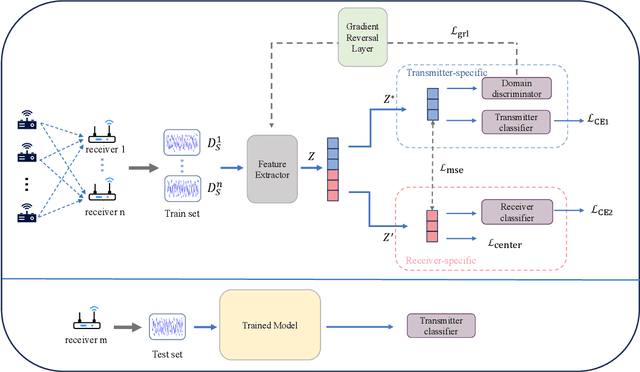
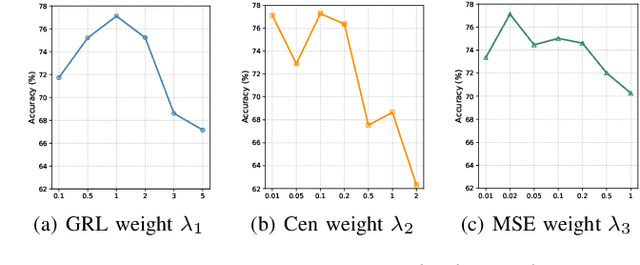
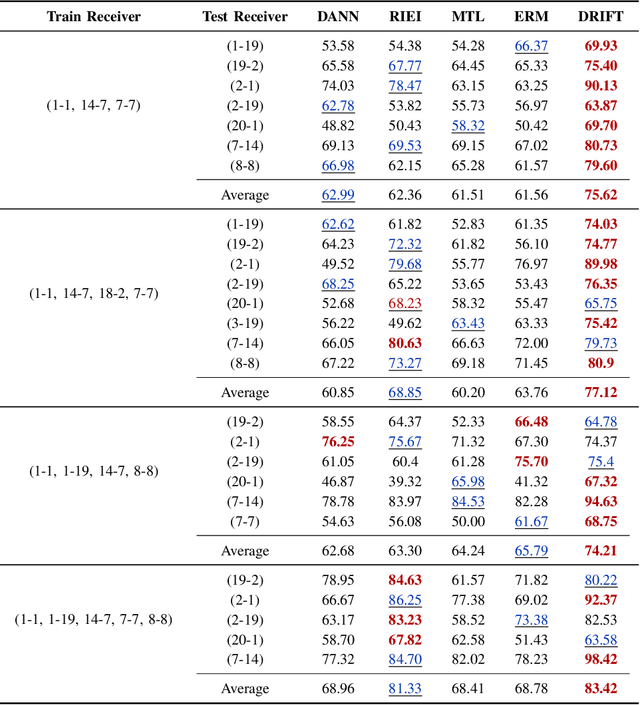
Abstract:Radio frequency fingerprint identification (RFFI) is a critical technique for wireless network security, leveraging intrinsic hardware-level imperfections introduced during device manufacturing to enable precise transmitter identification. While deep neural networks have shown remarkable capability in extracting discriminative features, their real-world deployment is hindered by receiver-induced variability. In practice, RF fingerprint signals comprise transmitter-specific features as well as channel distortions and receiver-induced biases. Although channel equalization can mitigate channel noise, receiver-induced feature shifts remain largely unaddressed, causing the RFFI models to overfit to receiver-specific patterns. This limitation is particularly problematic when training and evaluation share the same receiver, as replacing the receiver in deployment can cause substantial performance degradation. To tackle this challenge, we propose an RFFI framework robust to cross-receiver variability, integrating adversarial training and style transfer to explicitly disentangle transmitter and receiver features. By enforcing domain-invariant representation learning, our method isolates genuine hardware signatures from receiver artifacts, ensuring robustness against receiver changes. Extensive experiments on multi-receiver datasets demonstrate that our approach consistently outperforms state-of-the-art baselines, achieving up to a 10% improvement in average accuracy across diverse receiver settings.
Multibeam High Throughput Satellite: Hardware Foundation, Resource Allocation, and Precoding
Aug 01, 2025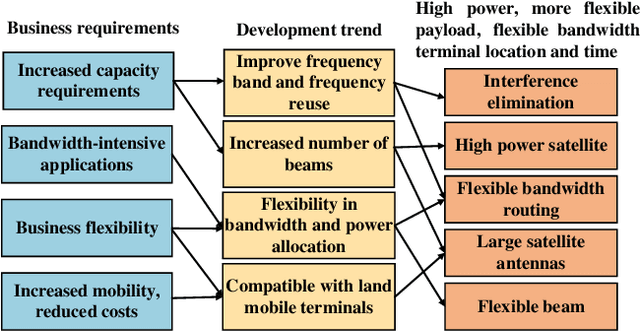
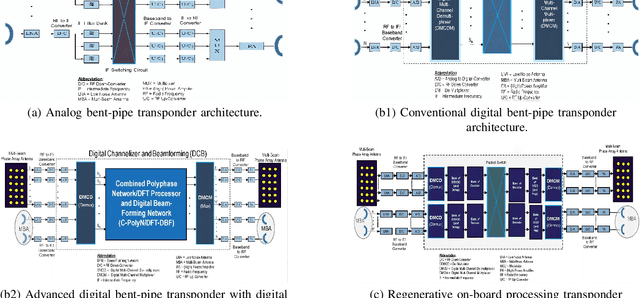
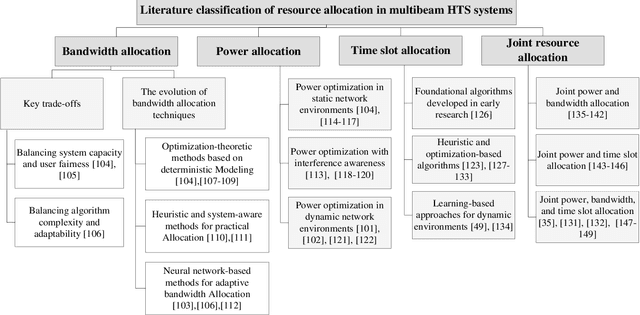
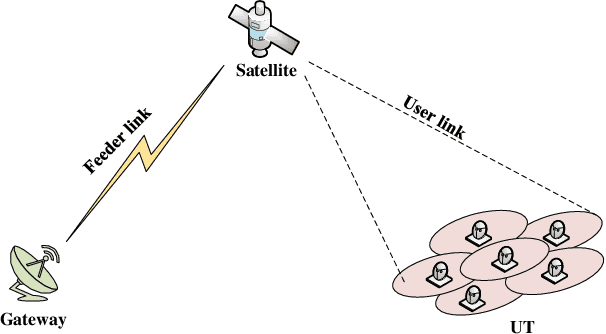
Abstract:With its wide coverage and uninterrupted service, satellite communication is a critical technology for next-generation 6G communications. High throughput satellite (HTS) systems, utilizing multipoint beam and frequency multiplexing techniques, enable satellite communication capacity of up to Tbps to meet the growing traffic demand. Therefore, it is imperative to review the-state-of-the-art of multibeam HTS systems and identify their associated challenges and perspectives. Firstly, we summarize the multibeam HTS hardware foundations, including ground station systems, on-board payloads, and user terminals. Subsequently, we review the flexible on-board radio resource allocation approaches of bandwidth, power, time slot, and joint allocation schemes of HTS systems to optimize resource utilization and cater to non-uniform service demand. Additionally, we survey multibeam precoding methods for the HTS system to achieve full-frequency reuse and interference cancellation, which are classified according to different deployments such as single gateway precoding, multiple gateway precoding, on-board precoding, and hybrid on-board/on-ground precoding. Finally, we disscuss the challenges related to Q/V band link outage, time and frequency synchronization of gateways, the accuracy of channel state information (CSI), payload light-weight development, and the application of deep learning (DL). Research on these topics will contribute to enhancing the performance of HTS systems and finally delivering high-speed data to areas underserved by terrestrial networks.
RadioDiff-3D: A 3D$\times$3D Radio Map Dataset and Generative Diffusion Based Benchmark for 6G Environment-Aware Communication
Jul 16, 2025Abstract:Radio maps (RMs) serve as a critical foundation for enabling environment-aware wireless communication, as they provide the spatial distribution of wireless channel characteristics. Despite recent progress in RM construction using data-driven approaches, most existing methods focus solely on pathloss prediction in a fixed 2D plane, neglecting key parameters such as direction of arrival (DoA), time of arrival (ToA), and vertical spatial variations. Such a limitation is primarily due to the reliance on static learning paradigms, which hinder generalization beyond the training data distribution. To address these challenges, we propose UrbanRadio3D, a large-scale, high-resolution 3D RM dataset constructed via ray tracing in realistic urban environments. UrbanRadio3D is over 37$\times$3 larger than previous datasets across a 3D space with 3 metrics as pathloss, DoA, and ToA, forming a novel 3D$\times$33D dataset with 7$\times$3 more height layers than prior state-of-the-art (SOTA) dataset. To benchmark 3D RM construction, a UNet with 3D convolutional operators is proposed. Moreover, we further introduce RadioDiff-3D, a diffusion-model-based generative framework utilizing the 3D convolutional architecture. RadioDiff-3D supports both radiation-aware scenarios with known transmitter locations and radiation-unaware settings based on sparse spatial observations. Extensive evaluations on UrbanRadio3D validate that RadioDiff-3D achieves superior performance in constructing rich, high-dimensional radio maps under diverse environmental dynamics. This work provides a foundational dataset and benchmark for future research in 3D environment-aware communication. The dataset is available at https://github.com/UNIC-Lab/UrbanRadio3D.
AI-based Environment-Aware XL-MIMO Channel Estimation with Location-Specific Prior Knowledge Enabled by CKM
Jul 08, 2025Abstract:Accurate and efficient acquisition of wireless channel state information (CSI) is crucial to enhance the communication performance of wireless systems. However, with the continuous densification of wireless links, increased channel dimensions, and the use of higher-frequency bands, channel estimation in the sixth generation (6G) and beyond wireless networks faces new challenges, such as insufficient orthogonal pilot sequences, inadequate signal-to-noise ratio (SNR) for channel training, and more sophisticated channel statistical distributions in complex environment. These challenges pose significant difficulties for classical channel estimation algorithms like least squares (LS) and maximum a posteriori (MAP). To address this problem, we propose a novel environment-aware channel estimation framework with location-specific prior channel distribution enabled by the new concept of channel knowledge map (CKM). To this end, we propose a new type of CKM called channel score function map (CSFM), which learns the channel probability density function (PDF) using artificial intelligence (AI) techniques. To fully exploit the prior information in CSFM, we propose a plug-and-play (PnP) based algorithm to decouple the regularized MAP channel estimation problem, thereby reducing the complexity of the optimization process. Besides, we employ Tweedie's formula to establish a connection between the channel score function, defined as the logarithmic gradient of the channel PDF, and the channel denoiser. This allows the use of the high-precision, environment-aware channel denoiser from the CSFM to approximate the channel score function, thus enabling efficient processing of the decoupled channel statistical components. Simulation results show that the proposed CSFM-PnP based channel estimation technique significantly outperforms the conventional techniques in the aforementioned challenging scenarios.
Latent Diffusion Model Based Denoising Receiver for 6G Semantic Communication: From Stochastic Differential Theory to Application
Jun 06, 2025Abstract:In this paper, a novel semantic communication framework empowered by generative artificial intelligence (GAI) is proposed, specifically leveraging the capabilities of diffusion models (DMs). A rigorous theoretical foundation is established based on stochastic differential equations (SDEs), which elucidates the denoising properties of DMs in mitigating additive white Gaussian noise (AWGN) in latent semantic representations. Crucially, a closed-form analytical relationship between the signal-to-noise ratio (SNR) and the denoising timestep is derived, enabling the optimal selection of diffusion parameters for any given channel condition. To address the distribution mismatch between the received signal and the DM's training data, a mathematically principled scaling mechanism is introduced, ensuring robust performance across a wide range of SNRs without requiring model fine-tuning. Built upon this theoretical insight, we develop a latent diffusion model (LDM)-based semantic transceiver, wherein a variational autoencoder (VAE) is employed for efficient semantic compression, and a pretrained DM serves as a universal denoiser. Notably, the proposed architecture is fully training-free at inference time, offering high modularity and compatibility with large-scale pretrained LDMs. This design inherently supports zero-shot generalization and mitigates the challenges posed by out-of-distribution inputs. Extensive experimental evaluations demonstrate that the proposed framework significantly outperforms conventional neural-network-based semantic communication baselines, particularly under low SNR conditions and distributional shifts, thereby establishing a promising direction for GAI-driven robust semantic transmission in future 6G systems.
Patient-Specific Dynamic Digital-Physical Twin for Coronary Intervention Training: An Integrated Mixed Reality Approach
May 16, 2025Abstract:Background and Objective: Precise preoperative planning and effective physician training for coronary interventions are increasingly important. Despite advances in medical imaging technologies, transforming static or limited dynamic imaging data into comprehensive dynamic cardiac models remains challenging. Existing training systems lack accurate simulation of cardiac physiological dynamics. This study develops a comprehensive dynamic cardiac model research framework based on 4D-CTA, integrating digital twin technology, computer vision, and physical model manufacturing to provide precise, personalized tools for interventional cardiology. Methods: Using 4D-CTA data from a 60-year-old female with three-vessel coronary stenosis, we segmented cardiac chambers and coronary arteries, constructed dynamic models, and implemented skeletal skinning weight computation to simulate vessel deformation across 20 cardiac phases. Transparent vascular physical models were manufactured using medical-grade silicone. We developed cardiac output analysis and virtual angiography systems, implemented guidewire 3D reconstruction using binocular stereo vision, and evaluated the system through angiography validation and CABG training applications. Results: Morphological consistency between virtual and real angiography reached 80.9%. Dice similarity coefficients for guidewire motion ranged from 0.741-0.812, with mean trajectory errors below 1.1 mm. The transparent model demonstrated advantages in CABG training, allowing direct visualization while simulating beating heart challenges. Conclusion: Our patient-specific digital-physical twin approach effectively reproduces both anatomical structures and dynamic characteristics of coronary vasculature, offering a dynamic environment with visual and tactile feedback valuable for education and clinical planning.
Anti-Intercept OFDM Waveform Design with Secure Coding for Satellite Networks
Apr 30, 2025Abstract:Low Earth Orbit (LEO) satellite networks are integral to next-generation communication systems, providing global coverage, low latency, and minimal signal loss. However, their unique characteristics, such as constrained onboard resources, Line-of-Sight (LoS) propagation, and vulnerability to eavesdropping over wide coverage areas, present significant challenges to physical layer security. To address these challenges, this paper focuses on the design of anti-intercept waveforms for satellite-ground links within Orthogonal Frequency Division Multiplexing (OFDM) systems, aiming to enhance security against eavesdropping threats. We formulate a secrecy rate maximization problem that aims to balance secrecy performance and communication reliability under eavesdropping constraints and sub-carrier power limitations. To solve this non-convex optimization problem, we propose a bisection search-activated neural network (BSA-Net) that integrates unsupervised learning for secure coding optimization and bisection search for dynamic power allocation. The proposed method is structured in two stages: the first optimizes secure coding under power constraints, while the second allocates power across sub-carriers under eavesdropping constraints. Extensive simulation results demonstrate the efficacy of our approach, showcasing significant improvements in secrecy rate performance.
Innovative Integration of 4D Cardiovascular Reconstruction and Hologram: A New Visualization Tool for Coronary Artery Bypass Grafting Planning
Apr 28, 2025Abstract:Background: Coronary artery bypass grafting (CABG) planning requires advanced spatial visualization and consideration of coronary artery depth, calcification, and pericardial adhesions. Objective: To develop and evaluate a dynamic cardiovascular holographic visualization tool for preoperative CABG planning. Methods: Using 4D cardiac computed tomography angiography data from 14 CABG candidates, we developed a semi-automated workflow for time-resolved segmentation of cardiac structures, epicardial adipose tissue (EAT), and coronary arteries with calcium scoring. The workflow incorporated methods for cardiac segmentation, coronary calcification quantification, visualization of coronary depth within EAT, and pericardial adhesion assessment through motion analysis. Dynamic cardiovascular holograms were displayed using the Looking Glass platform. Thirteen cardiac surgeons evaluated the tool using a Likert scale. Additionally, pericardial adhesion scores from holograms of 21 patients (including seven undergoing secondary cardiac surgeries) were compared with intraoperative findings. Results: Surgeons rated the visualization tool highly for preoperative planning utility (mean Likert score: 4.57/5.0). Hologram-based pericardial adhesion scoring strongly correlated with intraoperative findings (r=0.786, P<0.001). Conclusion: This study establishes a visualization framework for CABG planning that produces clinically relevant dynamic holograms from patient-specific data, with clinical feedback confirming its effectiveness for preoperative planning.
RadioDiff-$k^2$: Helmholtz Equation Informed Generative Diffusion Model for Multi-Path Aware Radio Map Construction
Apr 22, 2025Abstract:In this paper, we propose a novel physics-informed generative learning approach, termed RadioDiff-$\bm{k^2}$, for accurate and efficient multipath-aware radio map (RM) construction. As wireless communication evolves towards environment-aware paradigms, driven by the increasing demand for intelligent and proactive optimization in sixth-generation (6G) networks, accurate construction of RMs becomes crucial yet highly challenging. Conventional electromagnetic (EM)-based methods, such as full-wave solvers and ray-tracing approaches, exhibit substantial computational overhead and limited adaptability to dynamic scenarios. Although, existing neural network (NN) approaches have efficient inferencing speed, they lack sufficient consideration of the underlying physics of EM wave propagation, limiting their effectiveness in accurately modeling critical EM singularities induced by complex multipath environments. To address these fundamental limitations, we propose a novel physics-inspired RM construction method guided explicitly by the Helmholtz equation, which inherently governs EM wave propagation. Specifically, we theoretically establish a direct correspondence between EM singularities, which correspond to the critical spatial features influencing wireless propagation, and regions defined by negative wave numbers in the Helmholtz equation. Based on this insight, we design an innovative dual generative diffusion model (DM) framework comprising one DM dedicated to accurately inferring EM singularities and another DM responsible for reconstructing the complete RM using these singularities along with environmental contextual information. Our physics-informed approach uniquely combines the efficiency advantages of data-driven methods with rigorous physics-based EM modeling, significantly enhancing RM accuracy, particularly in complex propagation environments dominated by multipath effects.
 Add to Chrome
Add to Chrome Add to Firefox
Add to Firefox Add to Edge
Add to Edge